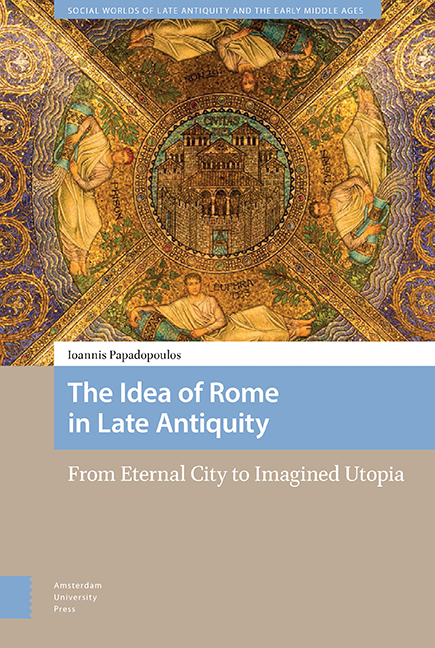Book contents
- Frontmatter
- Dedication
- Contents
- Introduction: Between a Physical and an Imaginary City
- I Looking Backwards: Ordo Renascendi
- II The Adventus of Constantius
- III Between Rome and Athens: The Artificial Romanitas of Julian
- IV Between the Altar and the Court: Symmachus and Claudian in Action
- V Between Christ and a Roman Place: The Emergence of Christian Rome in Time and Space
- VI Between Jerusalem and Babylon: The Archetype of Rome in the City of God
- Conclusions: From Rome to Eternity
- Bibliography
- Index
V - Between Christ and a Roman Place: The Emergence of Christian Rome in Time and Space
Published online by Cambridge University Press: 11 November 2021
- Frontmatter
- Dedication
- Contents
- Introduction: Between a Physical and an Imaginary City
- I Looking Backwards: Ordo Renascendi
- II The Adventus of Constantius
- III Between Rome and Athens: The Artificial Romanitas of Julian
- IV Between the Altar and the Court: Symmachus and Claudian in Action
- V Between Christ and a Roman Place: The Emergence of Christian Rome in Time and Space
- VI Between Jerusalem and Babylon: The Archetype of Rome in the City of God
- Conclusions: From Rome to Eternity
- Bibliography
- Index
Summary
Approaching the issue of the Christianization of the idea of Rome and Romanitas as well as the emergence of Christian Roman patriotism during the second half of the fourth century AD, one must turn to the development and evolution of various religious and social tensions within the old capital. In order to reflect on such a multidimensional and complex topic, one needs to combine the study not only of the ideas and motives of the protagonists of those interesting times, but also the evolution of Rome's sacral geography and symbolism, which would gradually be incorporated into the new image of the city as the capital of Christianity. While attempting to deconstruct and analyse, layer by layer, the stages of how the city of Romulus and Remus evolved into the city of the apostles and martyrs, one must consider how Rome came to be a new city. Rome indeed was in a state of ‘creative’ turbulence, which was expressed through conflicts about status and control over the public space within and outside the walls. The city had been a spiritual and ideological battlefield, not, however, as traditional historiography once thought, between pagans and Christians, but within the Christian audience itself and its various factions and orientations. Rome was re-inventing itself in order to fit into the new Christian discourse of the Imperium Christianum and preserve its symbolic primacy in the post-Constantinian Roman Empire. To paraphrase the famous Shakespearean quote, the eternal city became a stage and Bishop Damasus I (366-384) was a key player who, indeed, played many parts in all his exits and his entrances. In trying to combine its old idealism and its new needs as a Roman institution with a constantly expanding influence, the Roman Church was certainly between a rock and a hard place. The further mingling of Christianity and Romanitas came with a cost for the Church. Rising aristocratic involvement would carve a more systemic and authoritarian image of the ecclesiastical institutions, resulting in an identity crisis that would polarize even further the ideological differences of fourth-century Christianity. None of those paramount changes, of course, came out of the blue; the new tensions were largely dictated by the nature of the city itself and the symbolic importance of its landscape and this will be the primary focus of our attention in this chapter.
- Type
- Chapter
- Information
- The Idea of Rome in Late AntiquityFrom Eternal City to Imagined Utopia, pp. 151 - 174Publisher: Amsterdam University PressPrint publication year: 2021



